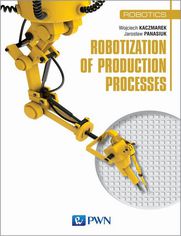Robotization of production processes - Helion

TĹ‚umaczenie: Agnieszka Adamczyk
ISBN: 978-83-01-20411-2
stron: 300, Format: ebook
Data wydania: 2019-04-09
Księgarnia: Helion
Cena książki: 59,20 zł (poprzednio: 73,09 zł)
Oszczędzasz: 19% (-13,89 zł)
Jest to praktyczne kompendium poświęcone ROBOTYCE, wprowadzające Czytelnika w arkana nowoczesnej wiedzy dotyczącej jednej z najbardziej rozwijających się technologii XXI wieku. Robotyzacja procesów produkcyjnych zapozna Czytelnika z wybranymi, zrobotyzowanymi procesami technologicznymi. Materiały zawarte w książce są wynikiem prac własnych autorów, jak również stanowią zbiór przykładów prezentujących rzeczywiste aplikacje zrobotyzowane. Publikacja poszerzona jest o zagadnienia opracowane na podstawie posiadanego zaplecza laboratoryjnego, w którego skład wchodzą stanowiska zrobotyzowanych procesów sortowania, pakowania, paletyzacji, klejenia, montażu, obsługi maszyn, spawania MIG/MAG, spawania laserowego, cięcia plazmą oraz zgrzewania. W tej praktycznej książce zawarte są również cechy rozwiązań technologicznych charakteryzujące poszczególne firmy produkujące roboty. Książka ze względu na praktyczność i sposób przekazu kierowana zarówno do studentów automatyki i robotyki czy mechatroniki, ale również do praktyków programistów robotów, integratorów automatyki, inżynierów i wielu innych.
Osoby które kupowały "Robotization of production processes", wybierały także:
- Elektronika. Od praktyki do teorii. Wydanie II 69,00 zł, (34,50 zł -50%)
- Termodynamika dla bystrzaków 49,00 zł, (26,95 zł -45%)
- Fascynujący świat robotów. Przewodnik dla konstruktorów 66,98 zł, (36,84 zł -45%)
- Sztuczna Inteligencja 49,00 zł, (26,95 zł -45%)
- Księga odkrywców LEGO Mindstorms NXT 2.0. Podstawy budowy i programowania robotów 49,00 zł, (26,95 zł -45%)
Spis treści
Robotization of production processes eBook -- spis treści
- Cover
- Title page
- Copyright page
- Table of Contents
- 1. Introduction
- 2. Basic concepts
- 2.1. Definitions of robots
- 2.2. Special uses of robots
- 2.3. Industrial robotics versus automation
- 2.4. Classification of industrial robots
- 2.5. Construction of industrial robots
- 2.6. Technical parameters of industrial robots
- 2.7. Selected constructions of industrial robots
- 2.7.1. Five- and six-axis articulated robots
- 2.7.2. Parallel robots
- 2.7.3. SCARA robots
- 2.7.4. Portal robots
- 2.7.5. Two-armed robots
- 2.7.6. Collaborative robots
- 2.8. Coordinate systems of industrial robots
- 3. Effectors of industrial robots
- 3.1. Grippers
- 3.2. Robotic tools
- 3.3. Tool change systems
- 4. Sensors and sensor systems of industrial robots
- 4.1. Measurement sensors
- 4.2. Vision systems
- 5. The use of industrial robots in selected applications
- 5.1. The advantages of robotization
- 5.2. Robotic welding stations
- 5.3. Packaging machines versus robots
- 5.4. New markets for robotics
- 5.5. Work in dangerous conditions
- 5.6. Constant development of robotics
- 6. Analysis of robotic sorting, packaging and palletizing processes
- 6.1. Designing robotic cells for sorting, packing and palletizing of products
- 6.2. Construction of robotic sorting, packaging and palletizing work cells
- 6.2.1. Robotic sorting of products
- 6.2.2. Robotic packaging of products
- 6.2.3. Robotic palletizing of products
- 6.3. Safety and work environment at sorting, packaging and palletizing workstations
- 6.4. Examples of robotic packaging and palletizing stations
- 7. Robotic processes of welding, laser welding and cutting
- 7.1. Robotic processes of arc welding
- 7.2. Robotic processes of welding
- 7.3. Examples of robotic welding stations
- 7.4. Robotic processes of laser cutting and welding
- 7.5. Summary
- 8. Robotic machine tending
- 8.1. Robotic machine tending of machining centers
- 8.2. Robotic tending of plastic forming stations
- 9. Robotic assembly
- 9.1. Types of assembly stations
- 9.2. Summary
- 10. Programmable Logic Controllers (PLCs) on robotic production cells
- 10.1. Role of PLCs in industry
- 10.2. Construction, operation and programming of PLCs
- 10.3. Immigration of PLCs to robot controllers
- 10.3.1. Examples of solutions
- 10.4. Summary
- 11. Safety systems at robotic workstations
- 11.1. Machine safety in the aspect of standards requirements
- 11.2. Safety categories
- 11.3. Safety in a robotic production cell
- 11.4. Safety systems vs. control systems of industrial robots
- 11.5. Summary
- 12. The market of robotics and the review of new solutions and trends
- 12.1. Density of robotization
- 12.2. Predictions on the development of robotization
- 12.3. The main factors influencing the development of robotization
- 12.4. Trends in the development of industrial robots
- 12.4.1. Construction of manipulators
- 12.4.2. Generations of controllers
- 12.4.3. Development of operator panels Teach Pendant panels
- 12.4.4. Development of safety systems of industrial robots
- 12.4.5. Development of industrial robots programming environments
- 12.4.6. Integrated systems for quick implementation
- 13. References
- Footnotes





